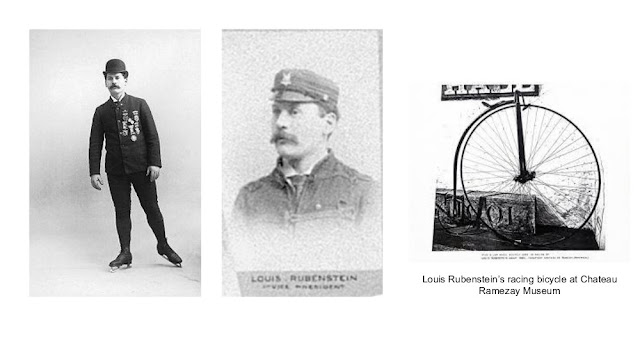Westmount Historical Association presentation on Montreal Bicycle Club: 9 - The 1899 International Cycling Association World Championship
The Victoria Skating rink was also the home rink of another important member of the Montreal Bicycle Club, Louis Rubenstein.
His parents were Polish Jews who had immigrated to Canada in the 1850’s. He took up figure skating as a child, inspired by a show given by American Jackson Haines, the father of modern figure skating. Louis saw him perform in Montreal when he was just 3 years old. As a teenager Louis went to Vienna to train under Jackson, and then went on to be the US champion figure skater in 1888 & 89. With a letter of introduction from Canadian Governor General Lord Stanley he travelled to St Petersburg, Russia for the figure skating world championship in 1890. St Petersburg at that time was a city “beyond the Pale” and it was forbidden for Jews to travel there. However, with a special request from the British embassy in St Petersburg he was permitted to compete, and became the world champion. He retired from figure skating shortly thereafter and after the 1894 CWA meet in Montreal became president of the Canadian Wheelmens Association, a post he held for 18 years.
In 1897 Louis Rubenstein had the Canadian Wheelmens Association sent a delegation to Glasgow Scotland in a to bid to hold the ICA World Championship in Canada, After the first World Championship in Chicago, all others had been held in Europe. It was felt that it was this side of the Atlantic’s turn once again. They lost the bid to Austria, but Sturmey agreed that if Canada sent a cycling team to Vienna in 1898, the 99 world championship would be held in this country. Louis Rubenstein then took on the job of selecting a team, and choosing a venue between various Canadian cities that wanted the event.
The cycling world’s organizations which had boomed in the early part of the 1890s’ began to unravel in the later half of that decade.
In the United States disagreements arose between racing promoters and the overall LAW over how a professional racing should be handled. Racing interests founded a rival National Cycling Association in 1898. Both organizations had a racing circuit and professional racers had to choose which circuit to join. Major Taylor, choose the LAW circuit despite the fact he was barred from actual membership within that organization.
In Canada, disputes between Toronto and Montreal over who which city would host the championship developed. Montreal’s case was strengthened when a new outdoor wood Velodrome
was constructed in Verdun by Ucal Henri Dandurand.
Ultimately this Velodrome could hold approx 10,000 spectators. Later, Dandurand was also the first man in Montreal to own an automobile.
In Europe disputes developed between France and Sturmey’s ICA over how many votes should be allocated to British Empire countries such as Scotland and Wales vs the single vote given to France.
All these forces came to a head when the 1899 Cycling Worlds Championship held at Queen’s Park in Verdun. Would France send a team? Which American racers would be permitted to compete the LAW or the NCA?
France did send a team and Sturmey, who had travelled to Montreal for the event, held a meeting in the Windsor Hotel, a few days before the championship to choose which American organization would he recognise. He decided in favor the League of American Wheelmen. This meant that Major Taylor,
who had just set a new world motor paced one mile speed record was the favorite along with the Butler brothers of Boston (the Butler brothers were both born in Halifax) for the highly contested 1 mile professional sprint.
They had all previously all been members of America’s first racially integrated professional sports team. Floyd “The Human Engine” McFarland , Taylor’s pugnacious, bigoted, chief rival was a star rider in the NCA and was not permitted to compete in Montreal.
The races at Queens park were held before a capacity 12,000 audience. In the half mile championship race it was widely felt that Major Taylor had won and yet the judges ruled against him.
This caused a large uproar in the crowd. However Taylor accepted the judge's decision like a gentleman, earning him much praise. Taylor went on to win the sprint 1 mile professional title becoming only the second black man in history to be a world champion in any sport. (The first was Canadian Black Boxer George Dixon.) The praise he earlier received soon turned to scorn from Sturmey however. Taylor refused to compete in the traditional match race between between the champions of the professional and amateur divisions. He felt that he had much to lose and nothing to gain from competing.
Also, because the NCA racers had not been permitted to compete, his world title was open to dispute.







Comments
Post a Comment